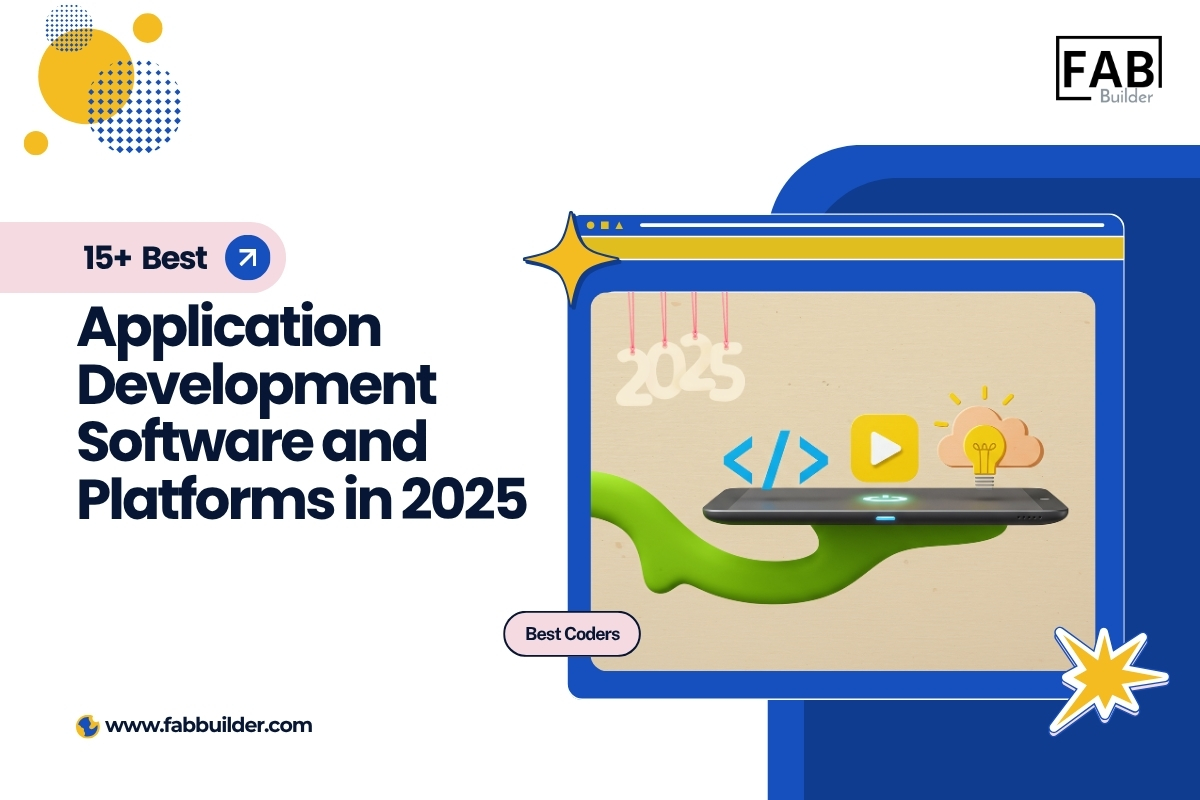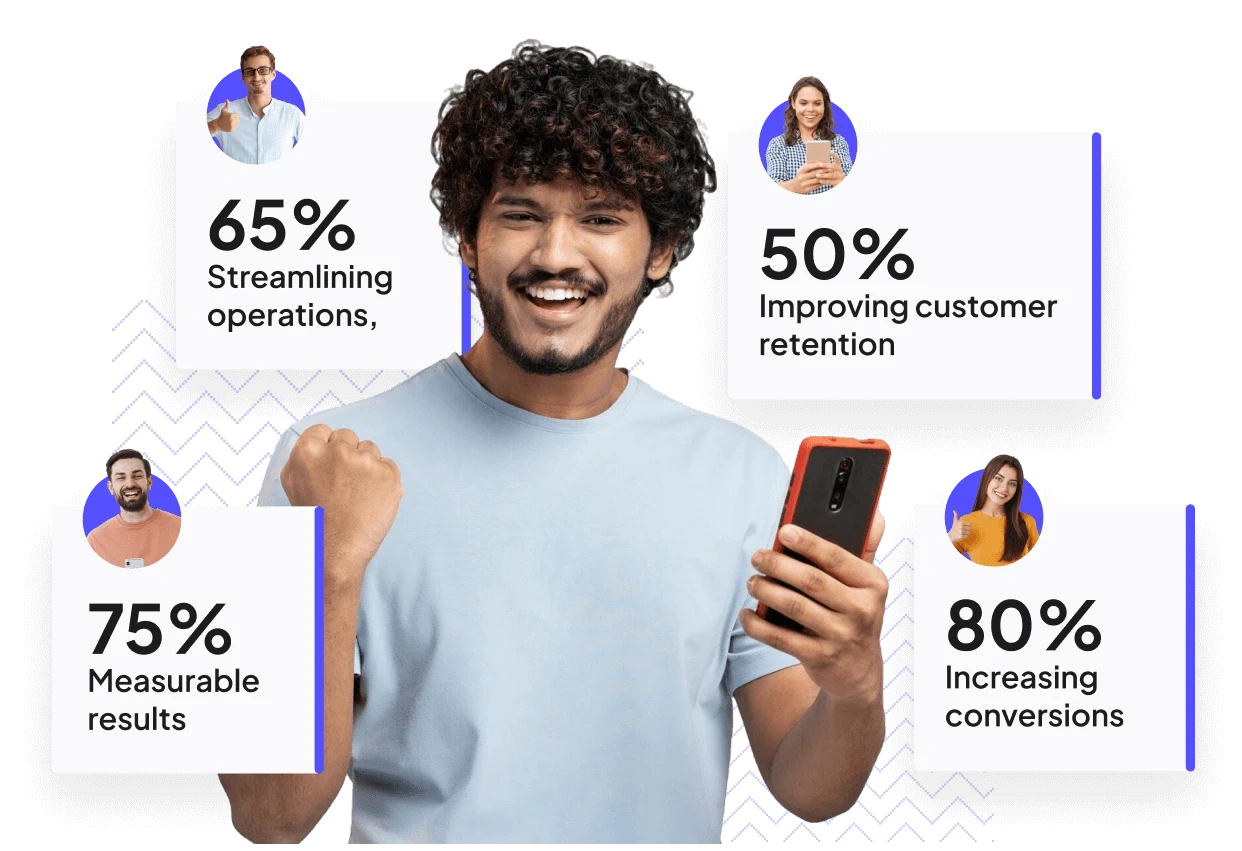Confused by the countless app development platforms out there? You’re not alone—and choosing the wrong one could cost you weeks of development time, thousands in resources, and a lot of frustration.
In 2025, building high-performing apps isn’t just about writing code—it’s about choosing the right application development software that fits your team, project, and business objectives. For developers, this means access to powerful frameworks and integrations. For startups, it means launching an MVP quickly. For enterprises, it’s about scalability, security, and cross-platform support.
From AI-powered tools to low-code/no-code platforms, there’s an overwhelming number of software for app development promising speed, efficiency, and scalability. But which app-making software truly delivers for your needs? And how can modern software for application development, like FAB Builder, help developers and non-technical teams build smarter, faster, and more efficiently?
In this guide, we’ll explore the top app dev platforms of 2025, compare their features, and give developers, product teams, and business owners actionable insights to choose the best app development platform—so you can stop guessing and start creating apps that perform and scale.
What is Application Development Software?
Application development software is a set of tools, platforms, and programs that allow developers, startups, and businesses to design, build, test, and deploy mobile or web applications efficiently. These tools simplify the complex process of coding while enabling teams to create high-quality apps that meet user expectations.
Depending on your needs, application development software can fall into several categories:
- Traditional Development Platforms
- Require coding expertise in languages like Java, Python, React, or Node.js.
- Give full control over app architecture, performance, and customization.
- Low-Code / No-Code Platforms
- Provide drag-and-drop interfaces and pre-built modules.
- Ideal for non-technical teams or developers who want faster prototyping.
- Examples include FAB Builder, which enables rapid full-stack app creation without compromising scalability.
- AI-Powered Development Software
- Automates repetitive coding tasks, testing, and optimization.
- Helps developers speed up delivery and reduce errors.
- Cross-Platform Development Tools
- Enable building apps that run on iOS, Android, and the web from a single codebase.
- Examples include Flutter, React Native, and Xamarin.
Using the right software for application development helps businesses save time, reduce costs, and deliver apps that perform reliably across devices. For developers, it also provides a framework for maintaining clean, reusable code while integrating modern features like AI, analytics, and third-party services.
Best App Development Platforms and Software to Use in 2025
Selecting the right app development platform can accelerate your projects, reduce costs, and ensure scalability. Here’s a detailed overview of some of the leading software for application development in 2025:
1. Zoho Creator
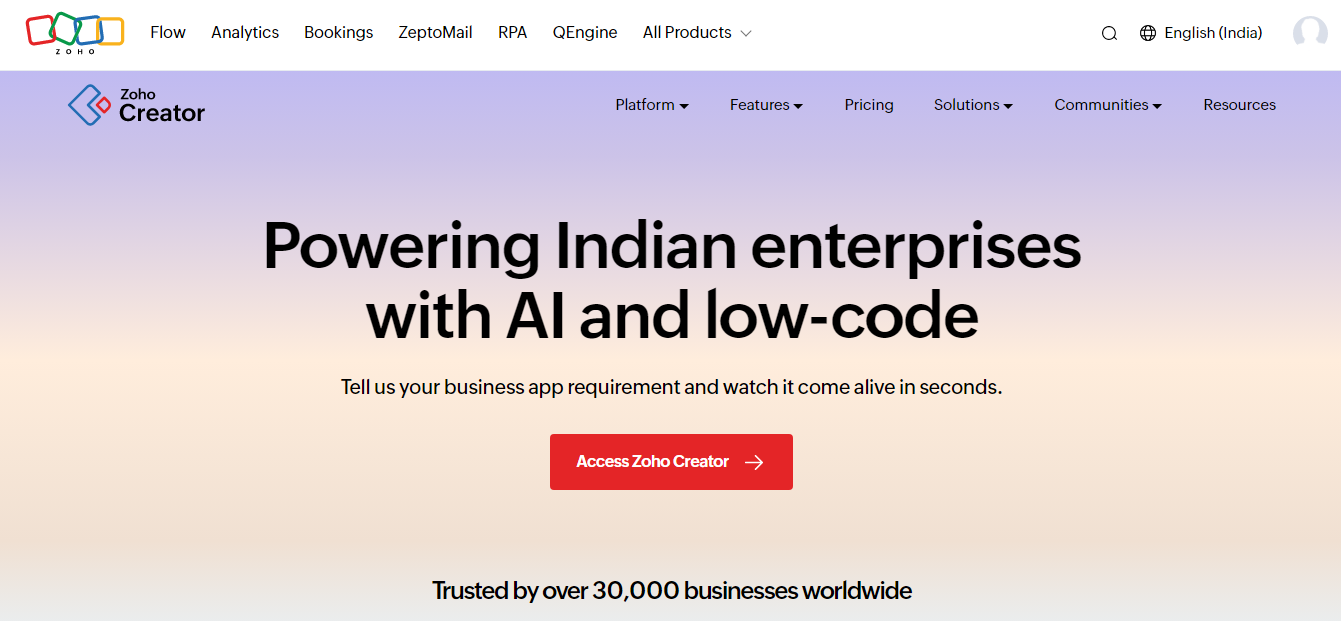
Zoho Creator is a cloud-based low-code platform designed for building custom applications quickly and efficiently. It allows businesses to automate workflows, manage data, and create apps that can run on the web and mobile without deep coding knowledge. Its integration with the Zoho ecosystem makes it a preferred choice for SMBs looking for affordable, scalable app solutions.
Key Features:
- Drag-and-Drop Interface: Easily design apps without coding.
- Zoho Ecosystem Integration: Seamlessly connects with Zoho CRM, Books, and other tools.
- Multi-Device Support: Apps work across mobile, tablet, and web.
- Workflow Automation: Automate repetitive business processes.
- Custom Reports and Analytics: Gain insights from app usage and data.
Advantages:
- Quick and affordable app development for SMBs.
- Minimal coding required.
- Supports workflow automation and reporting.
- Scalable as business needs grow.
Disadvantages:
- Limited advanced customization compared to enterprise-grade platforms.
- Performance may be affected for very large datasets.
- Some integrations outside the Zoho ecosystem may require extra effort.
Best For:
- SMBs looking for custom, scalable apps without coding expertise.
- Businesses are already using Zoho tools.
- Teams need workflow automation and reporting.
2. Mendix
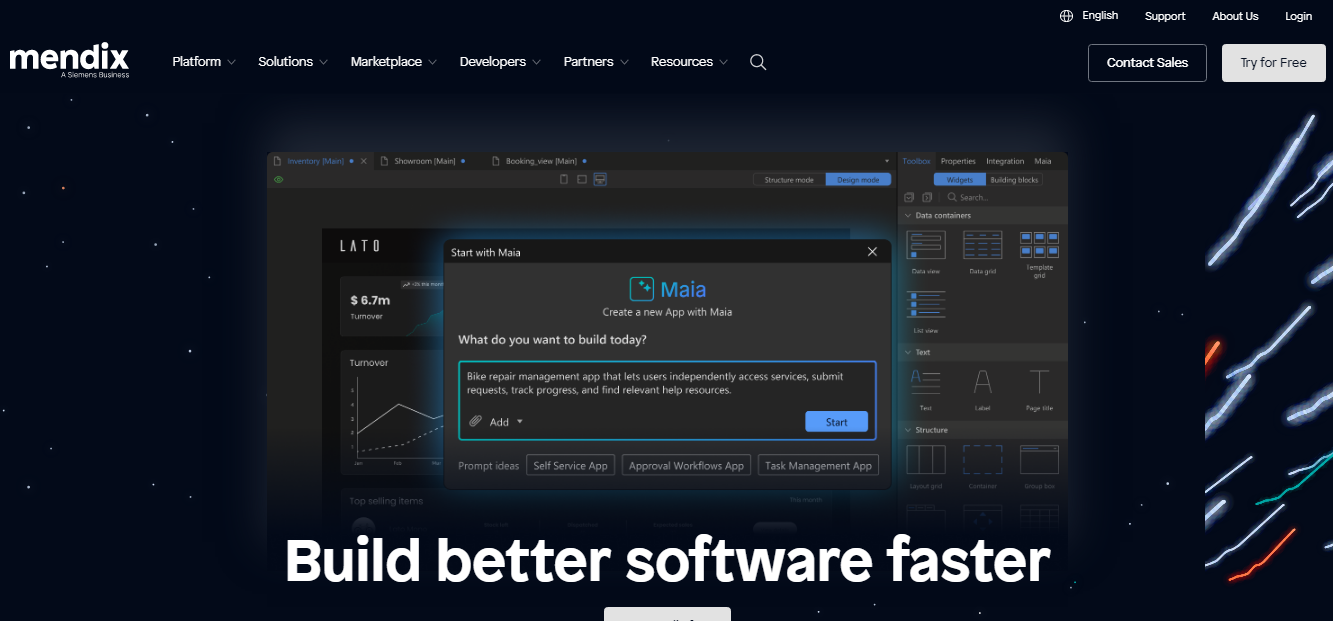
Mendix is a low-code platform designed for rapid application development, enabling organizations to build scalable and maintainable apps quickly. It supports visual modeling, cloud deployment, and collaborative workflows, making it ideal for enterprise development teams that want to reduce time-to-market while maintaining high-quality standards.
Key Features:
- Visual Modeling: Drag-and-drop interface for designing apps quickly.
- Cloud Deployment: Build, test, and deploy apps in the cloud.
- Collaboration Tools: Real-time team collaboration on app projects.
- Integration Capabilities: Connect with existing enterprise systems and APIs.
- Scalable Architecture: Designed for enterprise-grade applications.
Advantages:
- Reduces development time and costs.
- Supports collaboration between developers and business users.
- Scalable for large enterprise applications.
- Easy integration with existing systems and services.
Disadvantages:
- Learning curve for developers new to low-code platforms.
- Advanced customizations may require coding.
- Pricing may be high for smaller organizations.
Best For:
- Teams building scalable enterprise applications.
- Businesses seeking rapid app development with low-code.
- Organizations aiming to collaborate efficiently across development teams.
3. FAB Builder
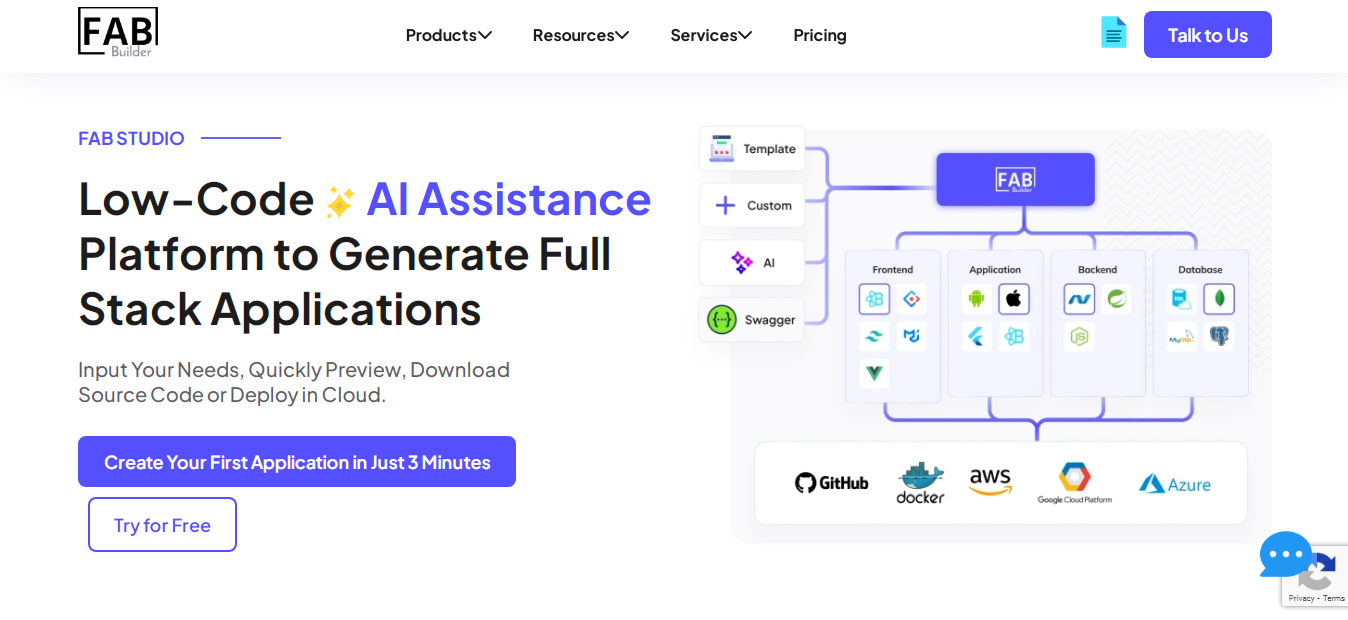
FAB Builder is an all-in-one app development platform for creating web and mobile applications with speed and flexibility. It combines low-code and AI-assisted workflows to enable both developers and non-technical users to build, deploy, and manage apps efficiently. Its multi-platform capabilities make it suitable for startups, SMEs, and enterprises aiming to launch apps faster and scale seamlessly.
Key Features:
- Entity-based Builder: Build interfaces quickly without coding.
- AI-Assisted Workflows: Automate coding, testing, and optimization tasks.
- Multi-Platform Deployment: Deploy apps on web, iOS, and Android simultaneously.
- Integration Capabilities: Connect with CRMs, payment gateways, and analytics tools.
- Collaboration Tools: Multiple team members can work simultaneously.
Advantages:
- Rapid app development for businesses of all sizes.
- AI-driven automation reduces manual work and errors.
- Cross-platform deployment saves time and resources.
- Accessible to both technical and non-technical users.
Disadvantages:
- Advanced customizations may require coding knowledge.
- Pricing may vary depending on app complexity and deployment scale.
- Some integrations may need additional configuration.
Best For:
- Startups and SMEs need rapid app development.
- Enterprises requiring flexible, scalable apps.
- Teams looking for AI-assisted app development workflows.
4. OutSystems
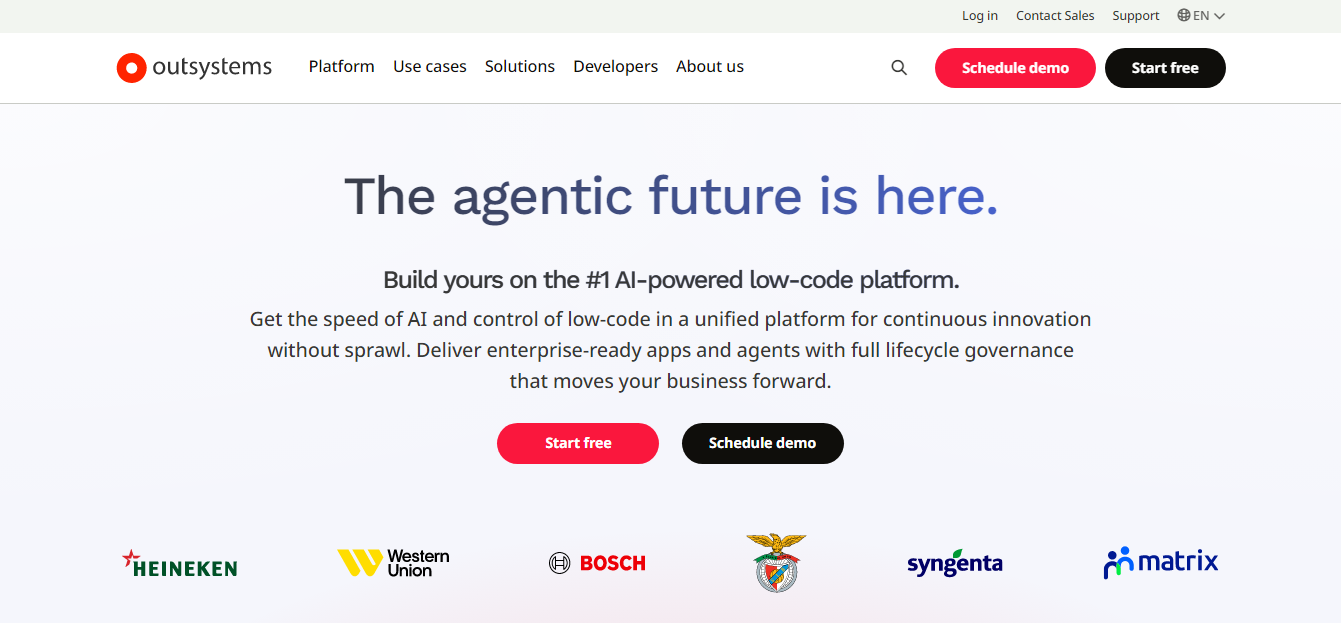
OutSystems is a low-code platform designed for enterprise-grade application development. It allows organizations to build complex applications quickly while maintaining control over performance, security, and scalability. OutSystems combines visual development tools with advanced features like real-time performance monitoring and enterprise integrations, making it ideal for businesses undergoing digital transformation.
Key Features:
- Visual Development Environment: Drag-and-drop interface for rapid app creation.
- Enterprise Integrations: Seamlessly connect with ERP, CRM, and other business systems.
- Real-Time Performance Monitoring: Track app health, usage, and performance.
- Cross-Platform Support: Build apps for web, mobile, and desktop.
- Scalable Architecture: Supports enterprise-level growth and complex app logic.
Advantages:
- Rapid app development with minimal coding.
- Enterprise-ready with robust security and integrations.
- Reduces development costs and accelerates time-to-market.
- Scalable for complex business applications.
Disadvantages:
- It can be expensive for smaller businesses or startups.
- Steeper learning curve for developers new to low-code platforms.
- Some customization may require traditional coding.
Best For:
- Enterprises are accelerating digital transformation.
- Teams need rapid development of scalable, high-performance applications.
- Businesses that require integration with existing enterprise systems.
5. Base44
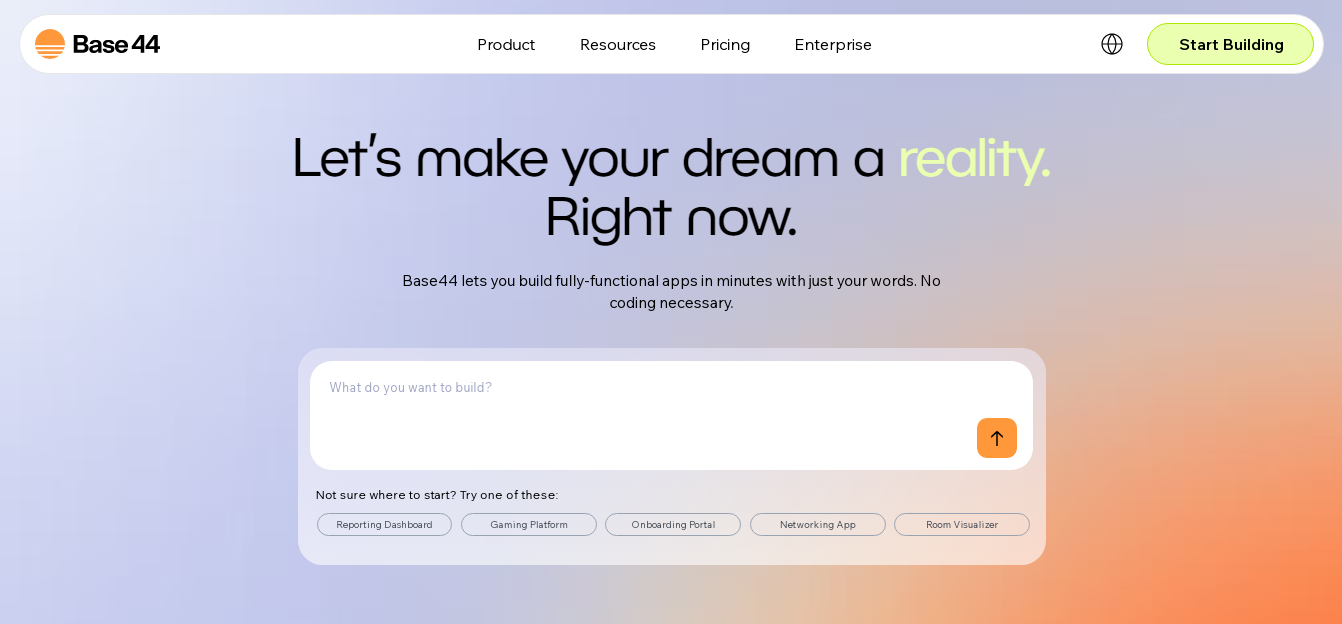
Base44 is a modern low-code platform designed to simplify and accelerate the process of application development for businesses of all sizes. It empowers developers, startups, and SMEs to create web and mobile applications quickly without getting bogged down in complex coding tasks. With Base44, teams can build scalable apps that integrate seamlessly with existing systems, deploy faster, and adapt easily as business requirements evolve. Its intuitive interface also allows non-technical users to contribute to app design and functionality, making it a perfect solution for collaborative development environments.
Key Features:
- Drag-and-Drop UI Builder: Quickly design user interfaces without coding, saving time and effort.
- Backend Integration: Connect your app with databases, APIs, and third-party tools effortlessly.
- Reusable Modules: Create and reuse components across multiple projects to improve development efficiency.
- Cross-Platform Deployment: Build apps that work on web, iOS, and Android from a single platform.
- Workflow Automation: Automate repetitive tasks to streamline app logic and improve performance.
- Collaboration Tools: Enable multiple team members to work simultaneously on the same project.
Advantages:
- Rapid development and prototyping for startups and SMEs.
- Minimal coding is required, making it accessible to non-developers.
- Reduces development costs and time-to-market.
- Supports integration with multiple services and APIs.
- Scalable architecture suitable for growing businesses.
Disadvantages:
- May lack full customization options compared to traditional coding platforms.
- Advanced features may require some technical expertise.
- Performance can be slightly limited for highly complex or resource-intensive apps.
- Dependent on the platform’s updates and support for certain integrations.
Best For:
- Startups building MVPs quickly.
- SMEs are looking to prototype apps efficiently.
- Teams with limited coding experience.
- Businesses that need rapid deployment and integration with existing tools.
6. Studio Creatio
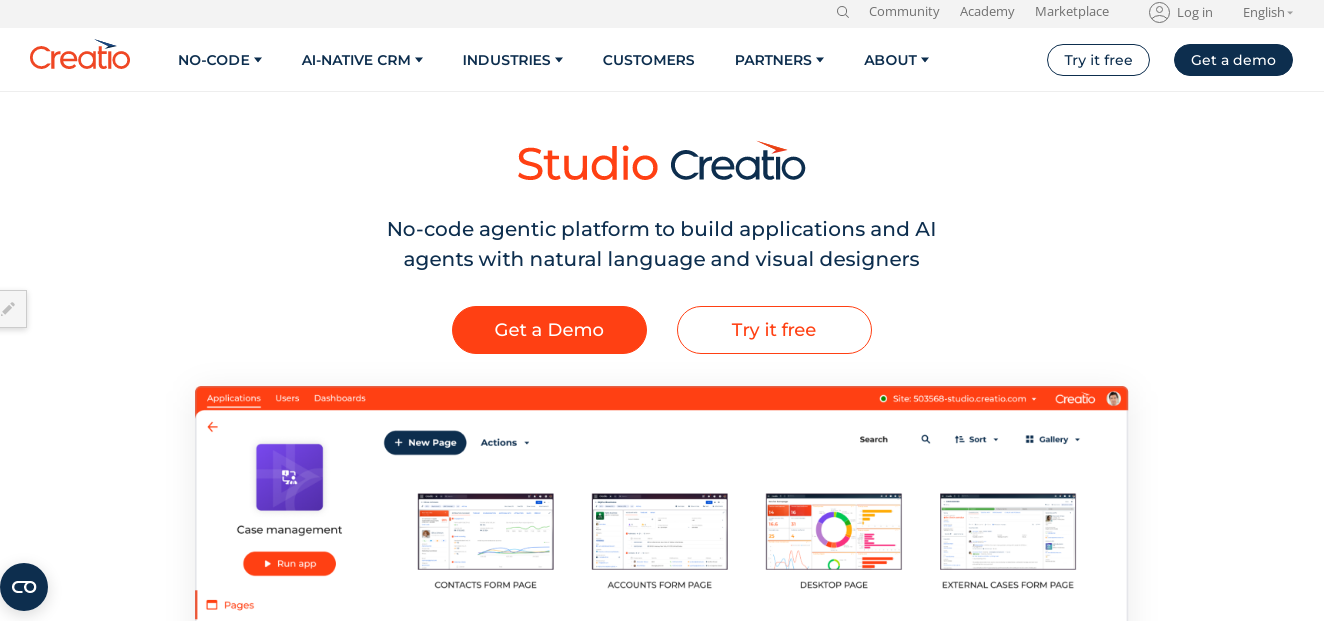
Studio Creatio is a process-driven no-code/low-code platform that empowers enterprises to automate workflows, manage customer relationships, and rapidly develop applications. Its focus on Business Process Management (BPM) allows teams to design, execute, and monitor business processes efficiently, ensuring that apps align perfectly with operational goals. Studio Creatio is particularly effective for organizations aiming to integrate workflow management with CRM solutions.
Key Features:
- BPM Engine: Design and automate complex business workflows.
- CRM Integration: Seamless connection with customer management tools.
- Workflow Automation: Automate repetitive tasks to enhance efficiency.
- Drag-and-Drop App Builder: Simplifies application creation for non-technical users.
- Analytics & Reporting: Monitor processes and track performance metrics.
Advantages:
- Streamlines business process automation.
- Bridges workflow and CRM applications seamlessly.
- Reduces manual intervention and human errors.
- Enables rapid app development for enterprise use.
Disadvantages:
- It can be complex for teams without BPM experience.
- Customization may require some technical knowledge.
- Pricing may be higher for smaller businesses.
Best For:
- Enterprises focused on workflow automation and CRM applications.
- Teams seeking process-driven app development.
- Businesses aiming for rapid deployment of enterprise apps.
7. Azure App Service
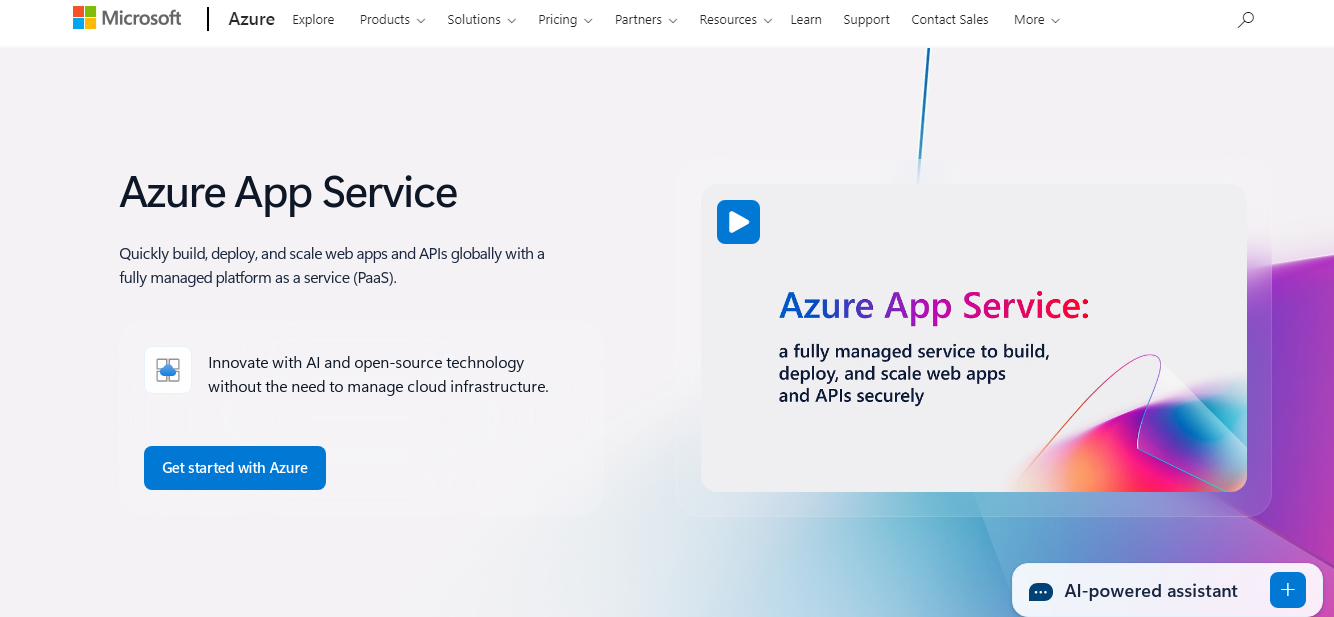
Azure App Service is Microsoft’s cloud-based platform for building, deploying, and scaling web and mobile applications. It provides developers with a robust environment that supports multiple programming languages, frameworks, and seamless integration with other Azure services. Azure App Service is ideal for creating enterprise-grade cloud apps that are secure, scalable, and globally available.
Key Features:
- Scalability: Automatically scale apps based on demand.
- Deployment Automation: Continuous integration and deployment with DevOps tools.
- Integration with Azure Services: Connects easily with databases, AI services, and analytics.
- Multi-Language Support: Supports .NET, Java, PHP, Node.js, Python, and more.
- High Availability & Security: Enterprise-grade compliance and reliability.
Advantages:
- Ideal for enterprise cloud app development.
- High scalability and performance.
- Supports continuous integration and deployment.
- Secure and compliant with global standards.
Disadvantages:
- It can be complex for beginners without Azure experience.
- Costs can increase with high-scale usage.
- Advanced configurations may require deep cloud knowledge.
Best For:
- Developers building enterprise-grade cloud applications.
- Teams seeking highly scalable and secure apps.
- Businesses leveraging the Azure ecosystem.
8. Appian
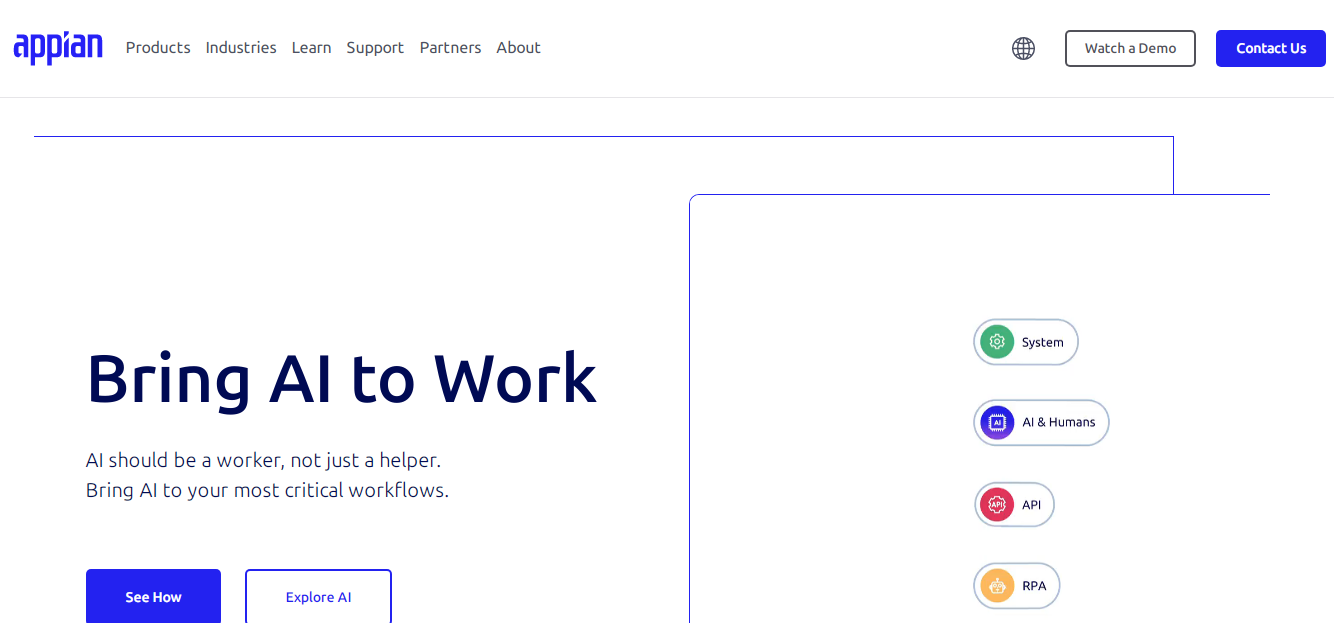
Appian is an enterprise-focused low-code platform that allows organizations to automate business workflows, build scalable applications, and integrate AI and RPA capabilities. It focuses on streamlining processes, improving operational efficiency, and accelerating digital transformation across large enterprises. Appian’s platform is designed to handle complex business needs while maintaining agility.
Key Features:
- Business Process Management (BPM): Automate and optimize enterprise workflows.
- AI & RPA Integration: Incorporate artificial intelligence and robotic process automation to reduce manual work.
- Low-Code Development: Rapidly build applications with minimal coding.
- Enterprise-Grade Security: Compliance and robust data protection.
- Scalability: Supports large-scale deployments across multiple departments.
Advantages:
- Accelerates enterprise workflow automation.
- Integrates advanced AI and RPA features.
- Reduces time-to-market for internal and external applications.
- High security and compliance standards.
Disadvantages:
- Requires training for business users to fully utilize BPM and automation features.
- Pricing may be high for small or medium-sized businesses.
- Less flexible for highly customized app requirements outside enterprise workflows.
Best For:
- Large enterprises are seeking workflow automation and digital transformation.
- Teams implementing AI-powered process optimization.
- Businesses require secure, scalable applications.
9. Rierino
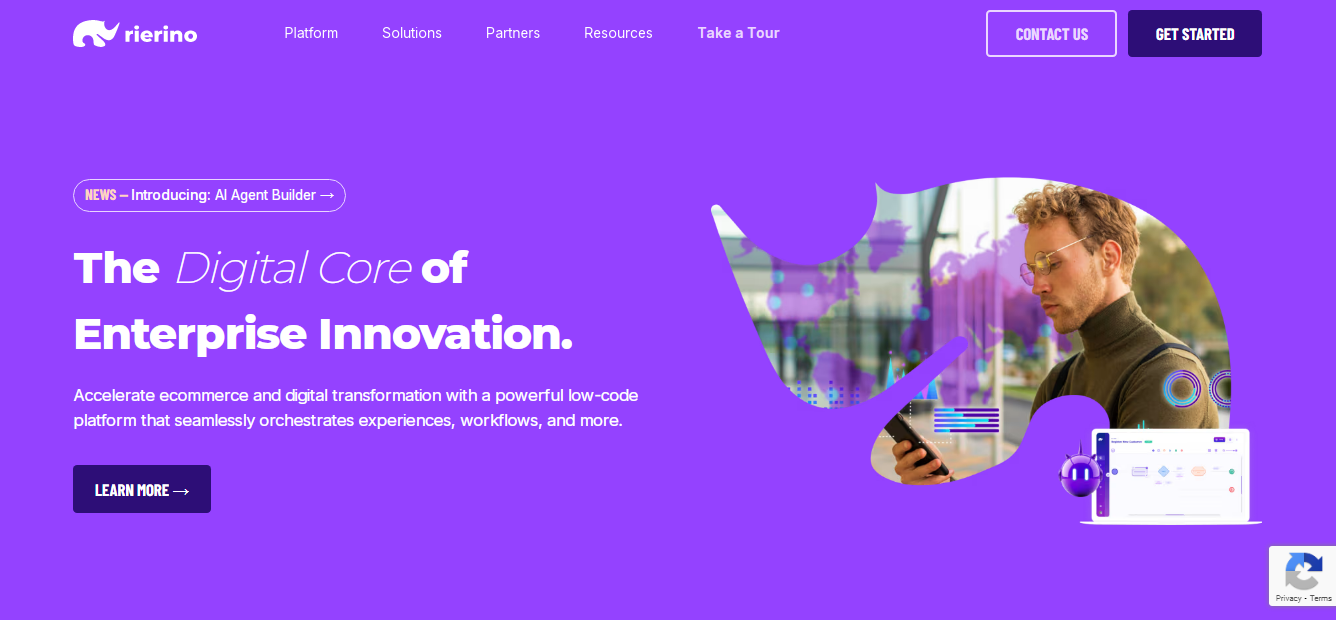
Rierino is a cloud-based development platform designed for creating both web and mobile applications efficiently. It enables development teams to build scalable, high-performance apps while leveraging cloud infrastructure for seamless deployment, real-time updates, and collaboration. With Rierino, developers can focus on innovation while the platform handles backend management, analytics, and multi-platform support.
Key Features:
- Multi-Platform Support: Build apps for web, iOS, and Android from a single development environment.
- Analytics Integration: Embedded analytics to track user behavior, performance, and engagement.
- Collaboration Tools: Real-time collaboration for distributed development teams.
- Cloud Deployment: Automatic cloud hosting and scaling options.
- API Connectivity: Integrates with existing business systems and third-party services.
Advantages:
- Simplifies cloud-native app development.
- Enables real-time collaboration among developers and business teams.
- Reduces infrastructure management overhead.
- Scalable and secure for enterprise-level projects.
Disadvantages:
- May require internet connectivity for full functionality.
- Less suitable for apps with very complex offline requirements.
- Advanced customization may need cloud architecture knowledge.
Best For:
- Development teams building cloud-native web and mobile apps.
- Businesses need real-time collaboration across teams.
- Organizations looking to leverage cloud scalability without heavy backend management.
10. Codeless ONE
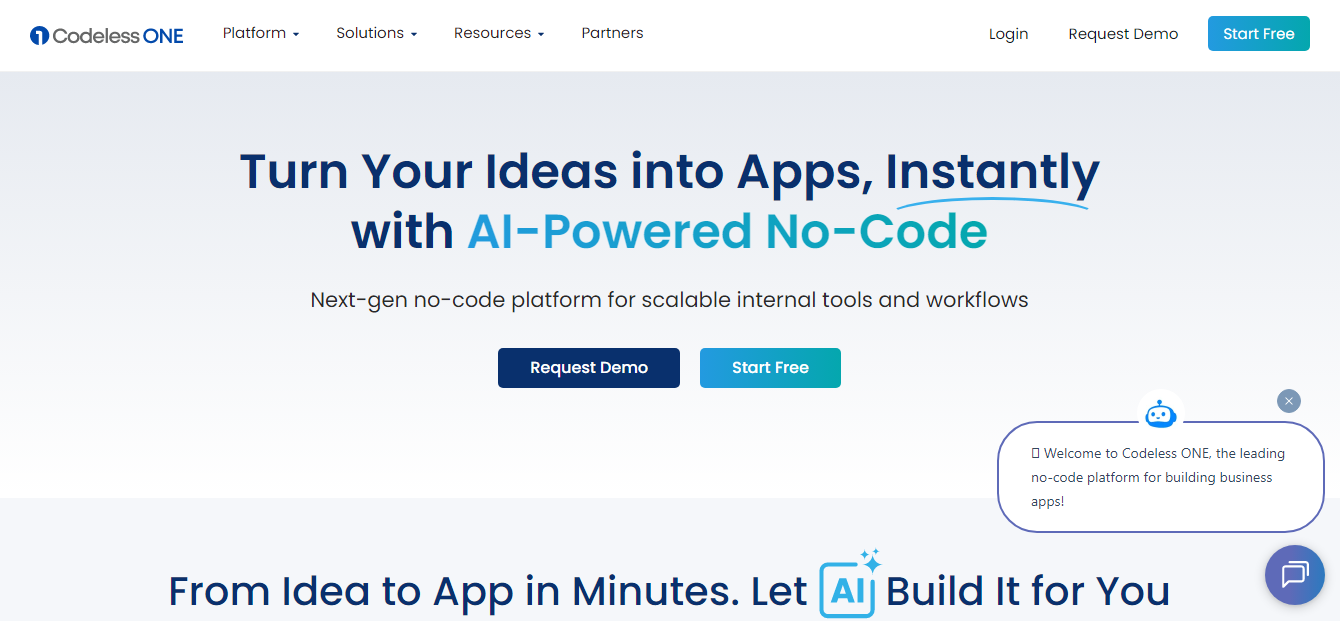
Codeless ONE is a no-code platform designed for building web and mobile applications without writing code. It enables non-technical users and startups to rapidly prototype, deploy, and manage apps while maintaining basic customization and integration capabilities. Its intuitive interface ensures that app development is accessible to business users, reducing dependency on developers for simple projects.
Key Features:
- Drag-and-Drop Editor: Design app interfaces visually without coding.
- Backend Integration: Connect to databases, APIs, and third-party services.
- Cross-Platform Support: Deploy apps on iOS, Android, and web platforms.
- Workflow Automation: Automate repetitive tasks within apps.
- Collaboration Tools: Multiple users can work on projects simultaneously.
Advantages:
- Enables rapid MVP launches.
- Accessible for non-technical users.
- Reduces development costs and time-to-market.
- Supports basic app integrations and workflows.
Disadvantages:
- Limited advanced customization compared to traditional coding.
- Performance may be limited for complex or large-scale apps.
- Some integrations may require additional configuration.
Best For:
- Non-technical users building quick prototypes or MVPs.
- Small businesses need internal apps quickly.
- Teams requiring basic cross-platform functionality.
11. Xcode
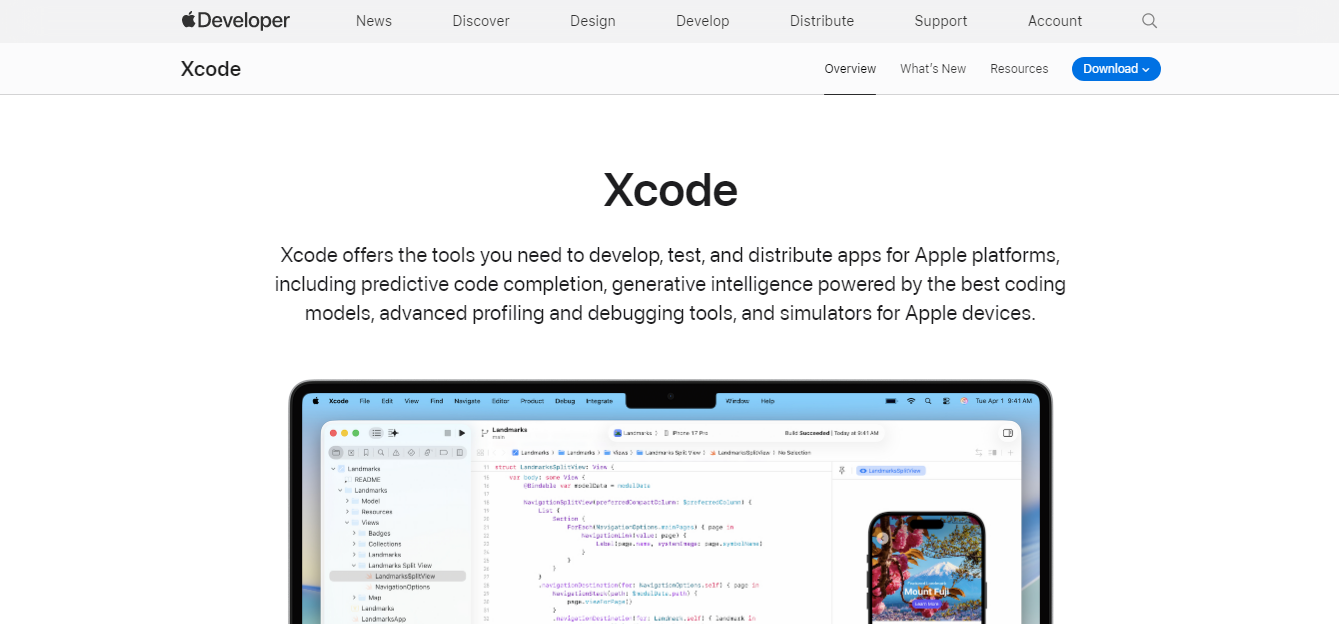
Xcode is Apple’s official integrated development environment (IDE) for creating applications across iOS, macOS, watchOS, and tvOS. It provides developers with powerful tools to write, test, and debug code using Swift or Objective-C, ensuring apps deliver native performance and optimal user experience on Apple devices.
Key Features:
- Swift Integration: Build apps using Apple’s modern programming language.
- Simulators: Test apps across multiple Apple devices virtually.
- Performance Tools: Debug, profile, and optimize application performance.
- Interface Builder: Drag-and-drop UI design for Apple platforms.
- App Store Deployment: Seamless publishing to Apple App Store.
Advantages:
- Native performance and optimized Apple ecosystem integration.
- Access to all Apple frameworks and APIs.
- Comprehensive debugging and testing tools.
- Ideal for professional iOS/macOS developers.
Disadvantages:
- Only available for macOS.
- Limited to Apple ecosystem apps.
- Steeper learning curve for beginners.
Best For:
- Developers building iOS, macOS, watchOS, or tvOS apps.
- Teams focused exclusively on Apple platforms.
- Professionals seeking native app performance and tools.
12. WebStorm
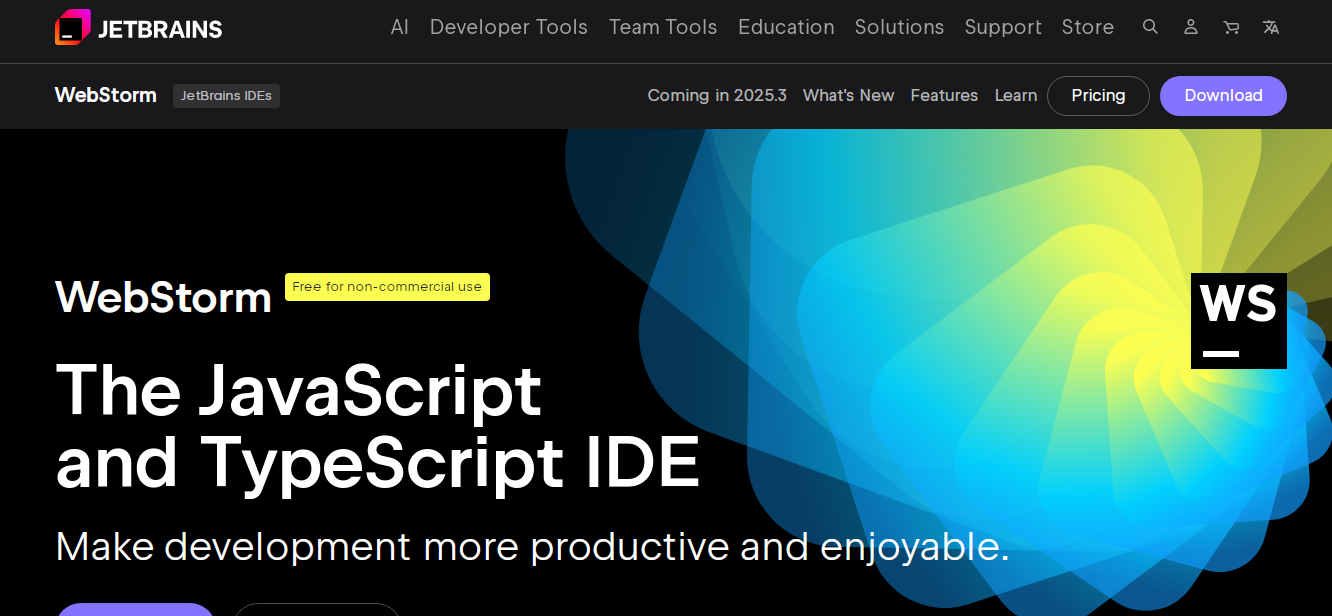
WebStorm is an IDE by JetBrains designed for JavaScript, TypeScript, and front-end frameworks. It offers intelligent coding assistance, debugging tools, and integration with Node.js, making it ideal for developers building complex web applications. WebStorm improves productivity through code analysis, navigation, and real-time error detection.
Key Features:
- Code Intelligence: Autocomplete, refactoring, and error detection.
- Debugging Tools: Built-in debugger for client-side and Node.js apps.
- Framework Integration: Supports React, Angular, Vue.js, and more.
- Version Control Integration: Git, GitHub, and other VCS supported.
- Testing & Profiling: Run unit tests and monitor performance efficiently.
Advantages:
- Powerful IDE for complex front-end development.
- Real-time error detection and debugging.
- Streamlines development workflows for JavaScript and TypeScript projects.
- Supports major web frameworks and tools.
Disadvantages:
- Paid subscription may not suit small teams or freelancers.
- Can be resource-intensive on older machines.
- Limited use for non-web or mobile-native apps.
Best For:
- Web developers building complex front-end apps.
- Teams using JavaScript, TypeScript, and modern frameworks.
- Projects requiring real-time debugging and code intelligence.
13. AppSheet
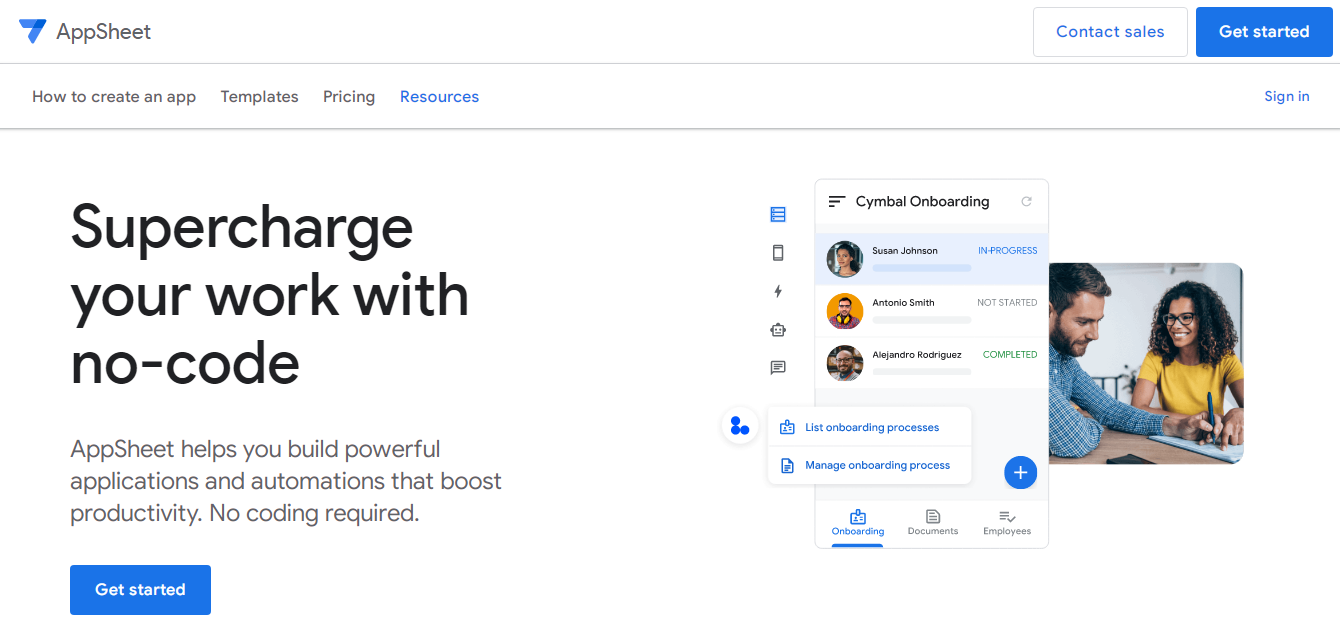
AppSheet is Google’s no-code platform that allows users to build mobile and web applications directly from spreadsheets and databases. It is designed for quick internal app creation, workflow automation, and multi-device deployment without coding knowledge, making it ideal for business users and small teams.
Key Features:
- No-Code App Builder: Create apps directly from Google Sheets, Excel, or databases.
- Automation & Workflow Integration: Automate tasks and approval processes.
- Multi-Device Deployment: Apps run seamlessly on mobile, tablet, and web.
- Data Security & Access Control: Role-based permissions for sensitive data.
- Custom Reports & Dashboards: Visualize app data for informed decisions.
Advantages:
- Rapid app creation for internal business needs.
- Accessible to non-technical users.
- Integrates easily with the Google ecosystem and other databases.
- Supports workflow automation and data reporting.
Disadvantages:
- Limited advanced customizations for complex apps.
- May not be suitable for public-facing, high-performance apps.
- Dependent on data source quality and structure.
Best For:
- Businesses need quick internal apps.
- Teams aiming to automate workflows.
- Organizations leveraging Google Sheets or databases for app development.
14. Appery
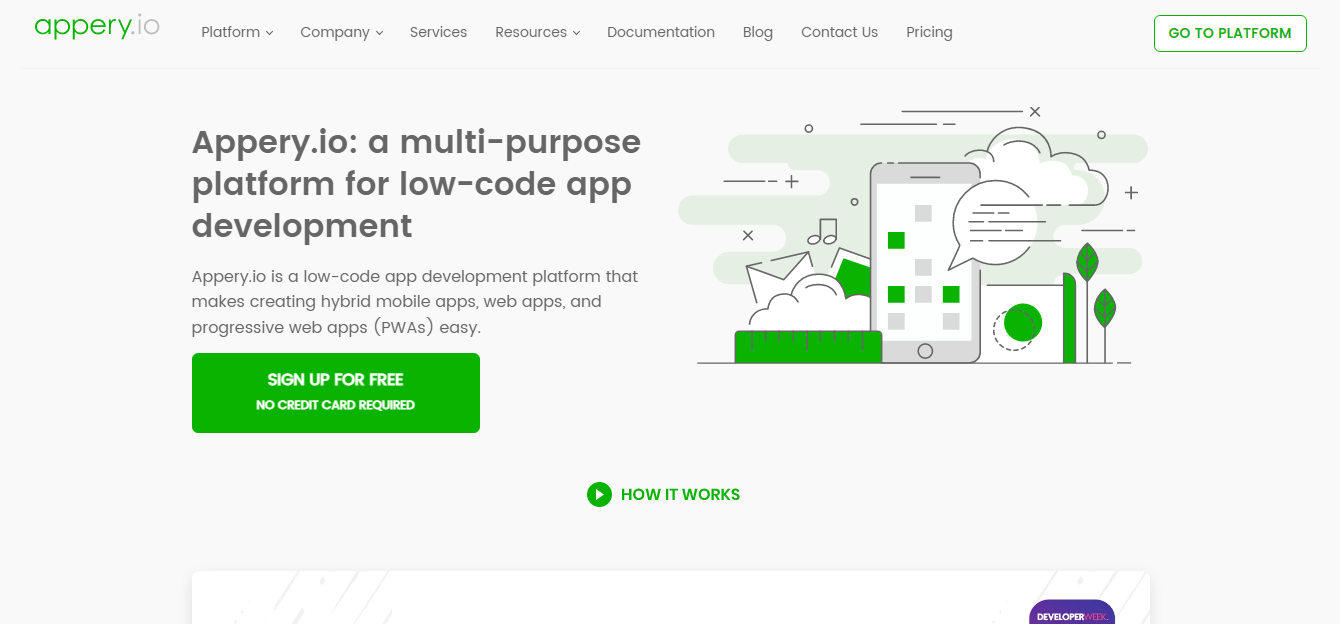
Appery is a cloud-based platform designed to simplify mobile application development, especially for startups and SMBs. It enables teams to build hybrid apps that work across multiple platforms using a visual interface. With integrated backend services and cloud hosting, Appery accelerates development while reducing infrastructure complexity.
Key Features:
- Visual Development: Drag-and-drop app builder for rapid creation.
- Backend Services: Includes databases, APIs, and cloud integration.
- Cloud Hosting: Deploy and manage apps directly in the cloud.
- Multi-Platform Support: Build hybrid apps for iOS, Android, and web.
- Collaboration Tools: Team members can work together on projects.
Advantages:
- Rapid development for hybrid apps.
- Accessible for teams with limited coding experience.
- Built-in backend services reduce setup time.
- Cloud hosting simplifies deployment and scaling.
Disadvantages:
- Limited customization for highly complex apps.
- Performance may vary compared to fully native apps.
- Pricing may increase for larger-scale apps or enterprise use.
Best For:
- Startups and SMBs are creating hybrid mobile apps.
- Teams need fast prototyping and cloud deployment.
- Businesses aiming for cross-platform reach without heavy coding.
15. Jira
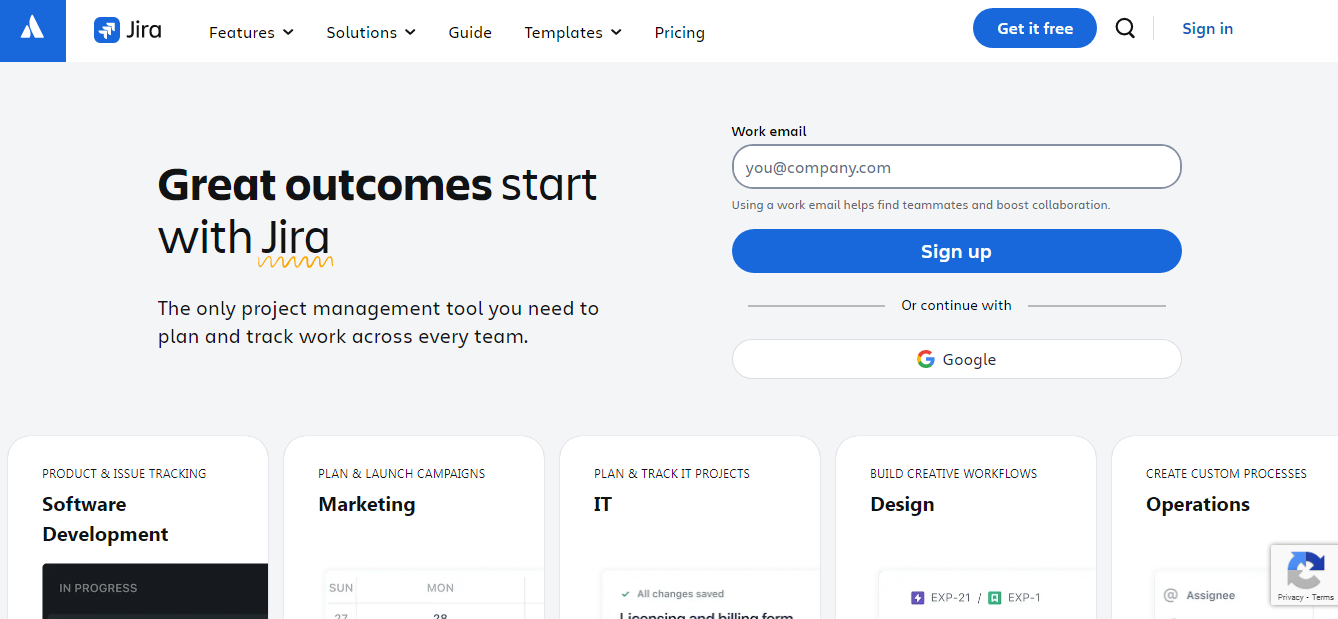
Jira is primarily a project management tool, now enhanced with capabilities to support software development tracking and plugins. It allows teams to manage agile projects, track workflows, and integrate with development tools, making it an essential platform for modern software teams.
Key Features:
- Agile Boards: Scrum, Kanban, and hybrid boards for project tracking.
- Workflow Tracking: Monitor progress, tasks, and bottlenecks.
- Integration with Dev Tools: Connect with Git, CI/CD pipelines, and IDEs.
- Reporting & Analytics: Track performance, velocity, and team productivity.
- Custom Plugins: Extend functionality for specific development needs.
Advantages:
- Streamlines project management and development tracking.
- Supports agile and hybrid project methodologies.
- Integrates with a wide range of developer tools.
- Provides insights through analytics and reporting.
Disadvantages:
- It can be complex for beginners without training.
- Overhead may be high for very small teams.
- Some advanced features require paid plans.
Best For:
- Teams managing software projects efficiently.
- Organizations using agile or hybrid methodologies.
- Developers requiring integration with CI/CD and dev tools.
16. Android Studio
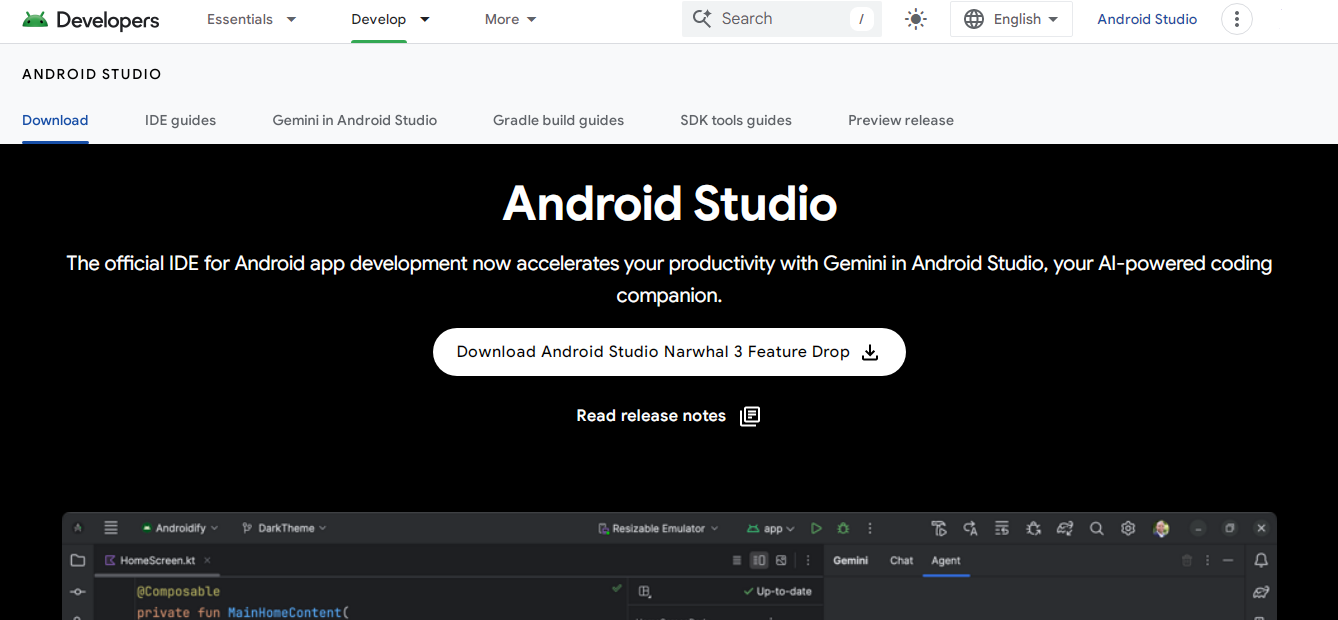
Android Studio is the official IDE for Android app development, providing developers with a comprehensive environment to design, code, debug, and test native Android applications. It supports Kotlin, Java, and C++ and comes with emulators, performance tools, and direct deployment to devices.
Key Features:
- Emulator: Test apps on multiple virtual devices.
- Code Editor: Intelligent coding assistance with autocomplete and refactoring.
- Debugging Tools: Identify and fix issues efficiently.
- Kotlin & Java Support: Official languages for Android development.
- App Deployment: Seamless publishing to Google Play Store.
Advantages:
- Full support for native Android apps.
- Robust testing and debugging environment.
- Frequent updates aligned with Android platform changes.
- Extensive developer community and resources.
Disadvantages:
- Learning curve for beginners.
- It can be resource-intensive on older computers.
- Limited to Android app development only.
Best For:
- Android developers building native mobile apps.
- Teams focused exclusively on the Android ecosystem.
- Developers need advanced debugging and testing tools.
17. AppGyver
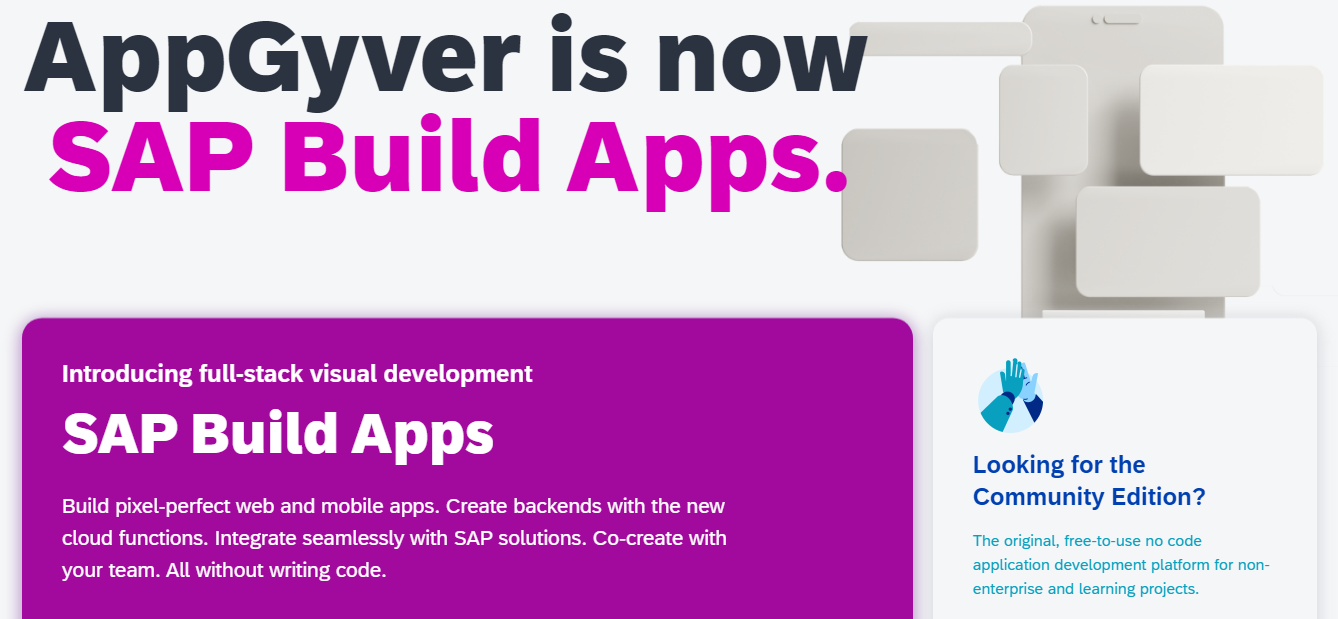
AppGyver is a no-code platform that allows users to build cross-platform apps for web, iOS, and Android without writing code. It is ideal for rapid prototyping, MVP creation, and non-technical users, providing a powerful drag-and-drop interface and logic flow system for app development.
Key Features:
- Drag-and-Drop UI: Create visually appealing app interfaces quickly.
- Backend Integration: Connect apps with APIs, databases, and third-party services.
- Logic Flows: Visual programming to handle app behavior and workflows.
- Cross-Platform Deployment: Build apps for multiple platforms simultaneously.
- Testing & Preview Tools: Test and preview apps in real-time.
Advantages:
- Enables rapid app prototyping.
- Accessible for non-technical users.
- Reduces development time and cost.
- Supports multi-platform deployment without coding.
Disadvantages:
- Limited advanced customization for complex apps.
- May not match the performance of fully native apps.
- Dependency on the platform’s features and updates.
Best For:
- Non-technical users building MVPs or prototypes.
- Startups and small teams require quick cross-platform apps.
- Businesses aim to validate ideas rapidly.
Why Use App Development Platforms? Key Benefits for Businesses and Developers
Using application development software and app development platforms provides businesses and developers with significant advantages. Whether you are a startup aiming for a fast MVP or an enterprise seeking scalable solutions, these platforms streamline the development process and enhance app quality.
1. Faster Development & Time-to-Market
App dev platforms like FAB Builder, OutSystems, and Mendix allow developers to leverage pre-built modules, AI-assisted interfaces, and reusable components. This reduces manual coding and accelerates development, helping businesses launch applications faster.
2. Reduced Development Costs
By minimizing the need for extensive coding and manual workflows, using software for application development lowers the costs associated with hiring large developer teams. Platforms also reduce maintenance expenses with built-in integrations and cloud deployment features.
3. Cross-Platform Support
Many app dev platforms support web, iOS, and Android simultaneously. This enables developers to create a single app that works across multiple devices, saving time and resources while reaching a wider audience.
4. Simplified Collaboration
Modern platforms provide tools for team collaboration, allowing developers, designers, and business stakeholders to work together in real-time. Features like version control, workflow management, and cloud-based editing improve efficiency and reduce errors.
5. Scalability & Flexibility
Platforms such as Azure App Service, OutSystems, and Base44 offer scalable infrastructure and flexible architecture, enabling apps to grow with your business. Teams can add new features or integrate with third-party services as requirements evolve.
6. Enhanced Security & Compliance
Enterprise-grade app dev platforms often include built-in security protocols, authentication mechanisms, and compliance features. This helps businesses protect sensitive data while meeting industry standards.
7. Integration with Tools & APIs
App development software often comes with pre-integrated APIs and third-party service connections, allowing teams to connect apps with CRM systems, analytics tools, and payment gateways effortlessly.
8. Ideal for Rapid Prototyping and MVPs
Platforms like Codeless ONE, AppGyver, and Rierino are perfect for creating prototypes or MVPs quickly. This enables startups and SMEs to test ideas, gather feedback, and iterate before full-scale development.
9. Accessibility for Non-Technical Users
No-code and low-code platforms democratize app creation, allowing business users or citizen developers to build functional applications without extensive programming knowledge.
10. Continuous Updates & Maintenance
Most app dev platforms offer automatic updates, bug fixes, and cloud maintenance, reducing the operational burden for development teams.
Top Features of App Development Software and Platforms
Modern application development software and app dev platforms provide a wide range of features that simplify the development process, improve efficiency, and enable teams to deliver high-quality applications. Here’s what you can expect from top platforms in 2025:
- Drag-and-Drop Interface: Most app-making software, like AppGyver and Codeless ONE, provides a visual drag-and-drop interface. This allows developers and non-technical users to design app layouts, UI elements, and workflows without writing complex code.
- Multi-Platform Deployment: App dev platforms often support cross-platform development, enabling a single codebase to run on iOS, Android, and the web. This feature saves time, reduces costs, and ensures a consistent user experience across devices.
- Pre-Built Templates and Modules: Many platforms include ready-to-use templates, components, and modules for common app functionalities such as login screens, dashboards, payment systems, and notifications. This speeds up development and ensures a professional design standard.
- Backend Integration: Top software for application development provides API integration and backend connectivity, allowing apps to interact with databases, third-party services, CRMs, analytics tools, and cloud storage seamlessly.
- Workflow & Automation Tools: Platforms like FAB Builder, Studio Creatio, Appian, and Rierino offer workflow automation, enabling teams to automate repetitive tasks, approvals, and notifications. This improves efficiency and reduces human error.
- AI & Intelligent Assistance: Modern app dev platforms increasingly integrate AI-powered features such as predictive analytics, automated testing, code suggestions, and intelligent workflows, enhancing productivity and app performance.
- Testing & Debugging Tools: Integrated testing environments, emulators, and debugging tools (like in Xcode, Android Studio, and WebStorm) allow developers to identify and fix errors, simulate different devices, and ensure the app works smoothly before deployment.
- Security & Compliance Features: Platforms include built-in security protocols, authentication, data encryption, and compliance tools to protect sensitive information and meet industry standards such as GDPR or HIPAA.
- Collaboration Tools: Cloud-based platforms provide real-time collaboration, enabling developers, designers, and business users to work together, track progress, and manage versions efficiently.
- Analytics & Reporting: Some app dev platforms include analytics dashboards to monitor app performance, user behavior, and engagement metrics, allowing teams to make data-driven decisions.
- Cloud Hosting & Deployment: Cloud-native platforms like Azure App Service and OutSystems allow automatic deployment, scaling, and hosting of applications, reducing infrastructure management overhead.
- Integration with CI/CD Pipelines: For professional developers, many platforms support continuous integration and continuous deployment, enabling faster updates, testing, and delivery of apps.
How to Select the Best App Development Software for Your Needs
Selecting the best application development software or app dev platform is crucial to ensure your project is successful, cost-effective, and scalable. With so many options available in 2025—from no-code platforms like AppGyver to enterprise-grade solutions like OutSystems and Azure App Service—making the right choice can be overwhelming. Here’s a step-by-step guide to help you decide.
1. Define Your Project Requirements
Start by identifying the scope and complexity of your application. Ask yourself:
- Is it a simple MVP or a complex enterprise solution?
- Will it be mobile-only, web-only, or cross-platform?
- What features are essential (e.g., AI integration, workflow automation, API connections)?
Clearly defining your requirements helps narrow down the platforms that fit your needs.
2. Consider Your Team’s Technical Expertise
Not all platforms require extensive coding knowledge.
- No-code platforms (e.g., Codeless ONE, AppGyver) are ideal for non-technical users or rapid prototyping.
- Low-code platforms (e.g., FAB Builder, Mendix) balance speed and flexibility for teams with some development experience.
- Traditional IDEs (e.g., Android Studio, Xcode, WebStorm) are best for professional developers building complex apps.
3. Evaluate Cross-Platform Capabilities
If you need an app to run on multiple devices, choose a platform that supports web, iOS, and Android. Platforms like Base44, OutSystems, and FAB Builder allow you to deploy a single codebase across multiple platforms, saving time and resources.
4. Check for Integration Options
Modern applications often require integration with:
- CRMs (e.g., Salesforce, Zoho, FAB CRM)
- Analytics tools
- Payment gateways
- Third-party APIs
Ensure the platform provides easy integration options without heavy custom coding.
5. Consider Scalability & Future Growth
Your chosen app development software should scale with your business. Enterprise-grade platforms like Azure App Service or Appian are ideal for long-term growth, while lightweight platforms like AppGyver are perfect for testing ideas or building MVPs.
6. Review Security & Compliance Features
For enterprise apps or applications handling sensitive data, choose platforms with:
- Built-in authentication and authorization
- Encryption and secure data storage
- Compliance with GDPR, HIPAA, or other industry standards
7. Assess Cost & Licensing
Consider your budget and long-term ROI. Some platforms charge per user, per app, or based on features. Balance cost against speed of development, scalability, and ongoing support.
8. Test with a Trial or Prototype
Before committing, test the platform using a trial version or build a small prototype. This helps evaluate:
- Ease of use
- Workflow efficiency
- Integration capabilities
- Performance and responsiveness
9. Seek Community Support & Documentation
Platforms with active communities, tutorials, and support resources can save you time and reduce the learning curve. Examples include FAB Builder, OutSystems, and Xcode.
10. Prioritize Speed & Efficiency
Ultimately, the right app development software should let you develop, deploy, and iterate quickly without compromising quality. Look for features like drag-and-drop builders, pre-built modules, AI-assisted workflows, and real-time testing tools.
Latest App Development Software Trends in 2025 You Should Know
The landscape of app development is evolving rapidly, influenced by technological advancements and changing user expectations. Here are the top trends shaping the industry in 2025:
1. AI-Powered Personalization
Artificial Intelligence (AI) is revolutionizing user experiences by enabling apps to deliver hyper-personalized content and interactions. From tailored recommendations in streaming services to adaptive learning paths in educational apps, AI is enhancing user engagement and satisfaction.
2. Low-Code and No-Code Development
Platforms like AppGyver and Codeless ONE are democratizing app development by allowing users with minimal coding knowledge to create functional applications. This trend is accelerating the development process and empowering a broader range of individuals to participate in app creation.
3. Cross-Platform Development Frameworks
Tools such as Flutter and React Native are enabling developers to build applications that run seamlessly on multiple platforms, including iOS, Android, and web browsers. This approach reduces development time and costs while ensuring a consistent user experience across devices.
4. Integration of Augmented Reality (AR) and Virtual Reality (VR)
AR and VR technologies are being increasingly integrated into mobile applications, offering immersive experiences in gaming, education, retail, and real estate. These technologies are enhancing user interaction and providing innovative solutions to traditional challenges.
5. 5G Connectivity
The rollout of 5G networks is facilitating faster data transfer speeds and more reliable connections, enabling the development of applications that require high bandwidth and low latency, such as real-time gaming, video streaming, and IoT applications.
6. Wearable Device Integration
With the proliferation of wearable devices like smartwatches and fitness trackers, developers are creating applications that integrate seamlessly with these devices to monitor health metrics, provide notifications, and enhance user convenience.
7. Blockchain Technology
Blockchain is being utilized in app development to enhance security, transparency, and trust, particularly in applications related to finance, supply chain management, and digital identity verification.
8. Progressive Web Apps (PWAs)
PWAs are gaining popularity due to their ability to provide a native app-like experience through a web browser. They offer benefits such as offline access, push notifications, and faster load times, making them an attractive option for businesses aiming to reach a wide audience without the need for app store distribution.
9. Cloud-Native Development
Cloud-native development practices are enabling developers to build scalable and resilient applications by leveraging cloud services and microservices architectures. This approach enhances flexibility and reduces infrastructure management overhead.
10. Enhanced Security Measures
As cyber threats become more sophisticated, developers are prioritizing security by implementing advanced authentication methods, data encryption, and secure coding practices to protect user data and maintain trust.
App Development Software Pricing: Costs, Plans, and Free Options
When choosing the right application development software or app dev platform, understanding pricing models is critical. Costs can vary widely based on features, platform type, deployment needs, and user scale. Here’s what you need to know in 2025:
1. Free & Open-Source Platforms
Some tools like AppGyver (Free Plan), Android Studio, and Xcode are available at no cost, making them ideal for startups, students, or small projects. Advantages include:
- No upfront costs.
- Large developer community support.
- Access to essential features for MVPs or prototypes.
Limitations:
- Limited enterprise features.
- No dedicated support.
- May require additional tools for backend integration or deployment.
2. Subscription-Based Pricing
Many app development platforms offer monthly or annual subscriptions, often tiered based on features and usage. Examples: FAB Builder, OutSystems, Mendix, Base44.
- Starter Plans: Usually range from $20–$100/month, offering basic app building, limited integrations, and user seats.
- Business Plans: Range from $100–$500/month, including advanced features like analytics, workflow automation, and multi-platform deployment.
- Enterprise Plans: Custom pricing for large-scale deployments, high-level integrations, security, and dedicated support.
Benefits:
- Predictable monthly or yearly costs.
- Access to updates, security patches, and new features.
- Scalable based on team size and app complexity.
3. Pay-Per-Feature or Usage-Based Pricing
Some platforms charge based on API calls, app usage, or active users. Examples include:
- Zoho Creator: Pricing may vary depending on app users and storage.
- AppSheet: Charges based on active app users per month.
Advantages:
- Flexible for startups and growing teams.
- Only pay for what you use.
Disadvantages:
- Costs may increase as your app scales.
- It can become unpredictable for high-traffic apps.
4. One-Time License Pricing
Traditional software for application development, like WebStorm or Appery, may offer one-time license fees or perpetual licenses.
- Pros: No recurring monthly payments.
- Cons: Updates and support may be limited unless purchased separately.
5. Additional Costs to Consider
Even after a platform subscription, other costs may apply:
- Cloud Hosting & Deployment: Some platforms include it; others charge extra.
- Third-Party Integrations: APIs, CRM tools, or analytics may have separate fees.
- Custom Development: Advanced features may require additional developer work.
- Maintenance & Support: Enterprise-level support packages may add to costs.
Conclusion: Pick the Perfect App Development Platform in 2025
Choosing the right app development software is more than just picking a tool—it’s about setting your project up for success. The platform you select determines how quickly you can bring ideas to life, streamline workflows, and deliver seamless experiences to your users. Whether you’re a startup testing a new concept, an SME scaling operations, or a developer building sophisticated apps, there’s a solution that fits your needs. From no-code platforms like AppGyver and Codeless ONE for rapid prototyping to enterprise-grade solutions like OutSystems, Mendix, and Azure App Service for large-scale applications, each platform offers unique advantages. Platforms like FAB Builder provide a perfect balance of speed, flexibility, and multi-platform deployment, enabling teams to build apps faster, reduce development costs, and focus on innovation rather than repetitive coding. Don’t let complexity slow you down—explore FAB Builder today, start building your app with ease, and transform your ideas into high-performing web and mobile applications that users love! Start building smarter apps today with FAB Builder – Free Trial!
Frequently Asked Questions
What is app development software?
App development software, also called application development software or platforms, is a tool that allows users to create, design, test, and deploy applications for web, mobile, or both. These platforms can be no-code, low-code, or traditional IDEs depending on the user’s technical expertise and project complexity.
Which is the best app development platform in 2025?
The best platform depends on your project needs and team expertise:
- No-Code / Low-Code: FAB Builder, AppGyver, Codeless ONE for rapid development and prototyping.
- Enterprise-Grade Platforms: OutSystems, Mendix, Azure App Service for scalable, secure apps.
- Developer-Focused IDEs: Android Studio, Xcode, WebStorm for fully custom applications.
Can I build apps without coding?
Yes! No-code and low-code platforms like AppGyver, Codeless ONE, and FAB Builder allow you to create apps using AI-assisted interfaces and pre-built modules, making them ideal for non-technical users or teams looking to save development time.
How much does app development software cost?
Costs vary depending on the platform:
- Free & Open-Source: AppGyver, Android Studio, Xcode (ideal for small projects or MVPs).
- Subscription-Based Plans: FAB Builder, OutSystems, Mendix ($20–$500/month depending on features and users).
- Enterprise Custom Pricing: For large teams requiring advanced features, integrations, and dedicated support.
Can app development platforms create cross-platform apps?
Yes. Many platforms like FAB Builder, Base44, OutSystems, and AppGyver support cross-platform development, allowing a single codebase to run on iOS, Android, and web without duplicating efforts.
Are these platforms suitable for enterprise applications?
Absolutely. Enterprise-grade platforms like OutSystems, Mendix, Appian, and Azure App Service are designed to handle large-scale applications, with robust security, workflow automation, integrations, and cloud deployment capabilities.
How do I choose the right app development software?
Consider these factors:
- Project complexity and goals (MVP, enterprise app, or prototype).
- Team expertise (developer-focused IDE or no-code/low-code platform).
- Budget and pricing model.
- Integration capabilities (APIs, CRM, analytics).
- Scalability and future growth.
Platforms like FAB Builder are ideal for businesses seeking flexibility, speed, and multi-platform deployment.
Can these platforms handle backend integration?
Yes. Most modern app development software supports API integration, databases, and cloud services, enabling apps to connect seamlessly with third-party services, CRMs, and analytics tools.
Do app development platforms include security features?
Yes. Enterprise and professional platforms often come with built-in security features, including data encryption, authentication, authorization, and compliance tools to meet industry standards like GDPR or HIPAA.
How can I test an app before deployment?
Most platforms offer emulators, testing tools, and preview modes. Developer IDEs like Xcode and Android Studio also provide advanced debugging and testing tools, while no-code platforms allow real-time testing across devices.
